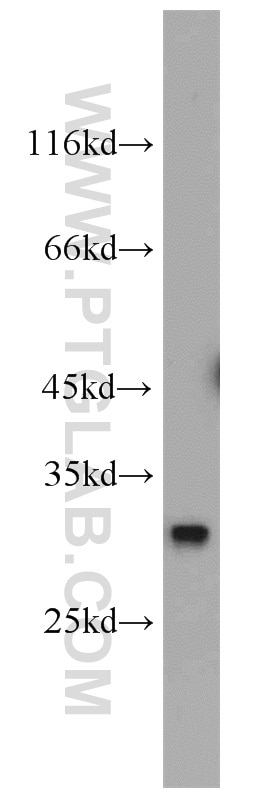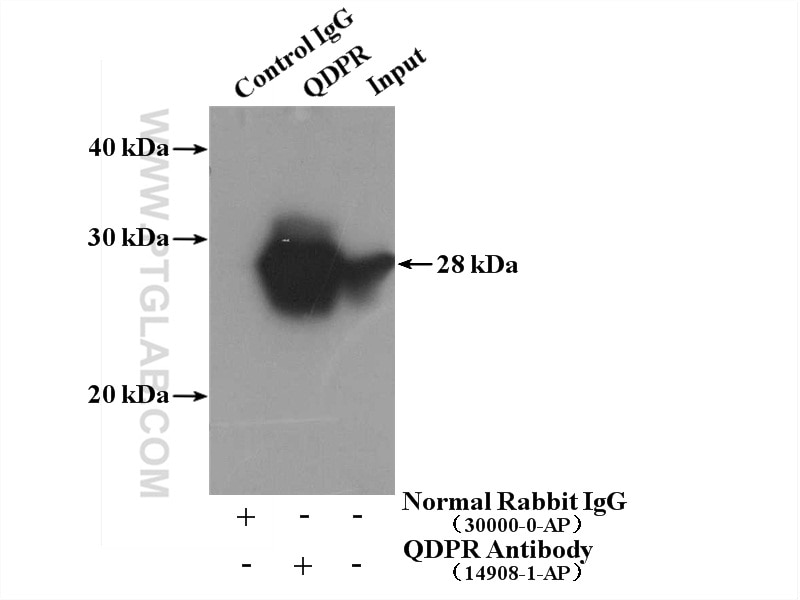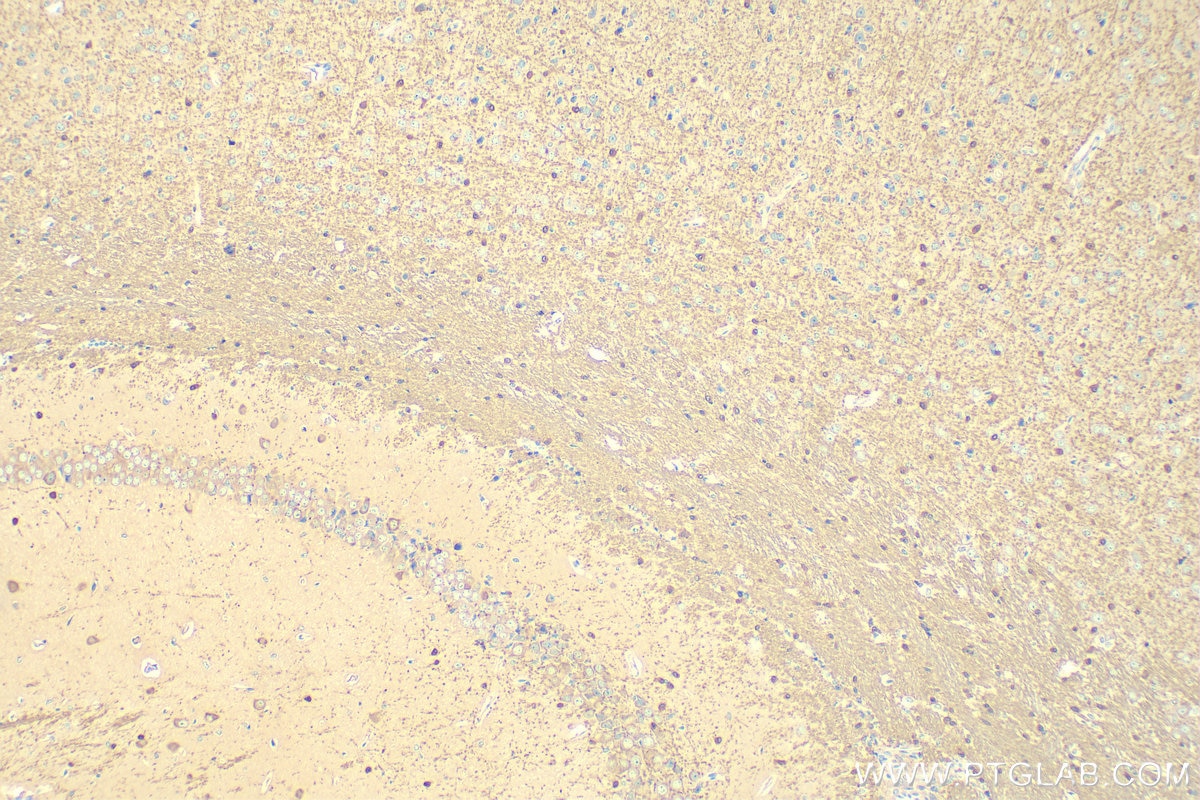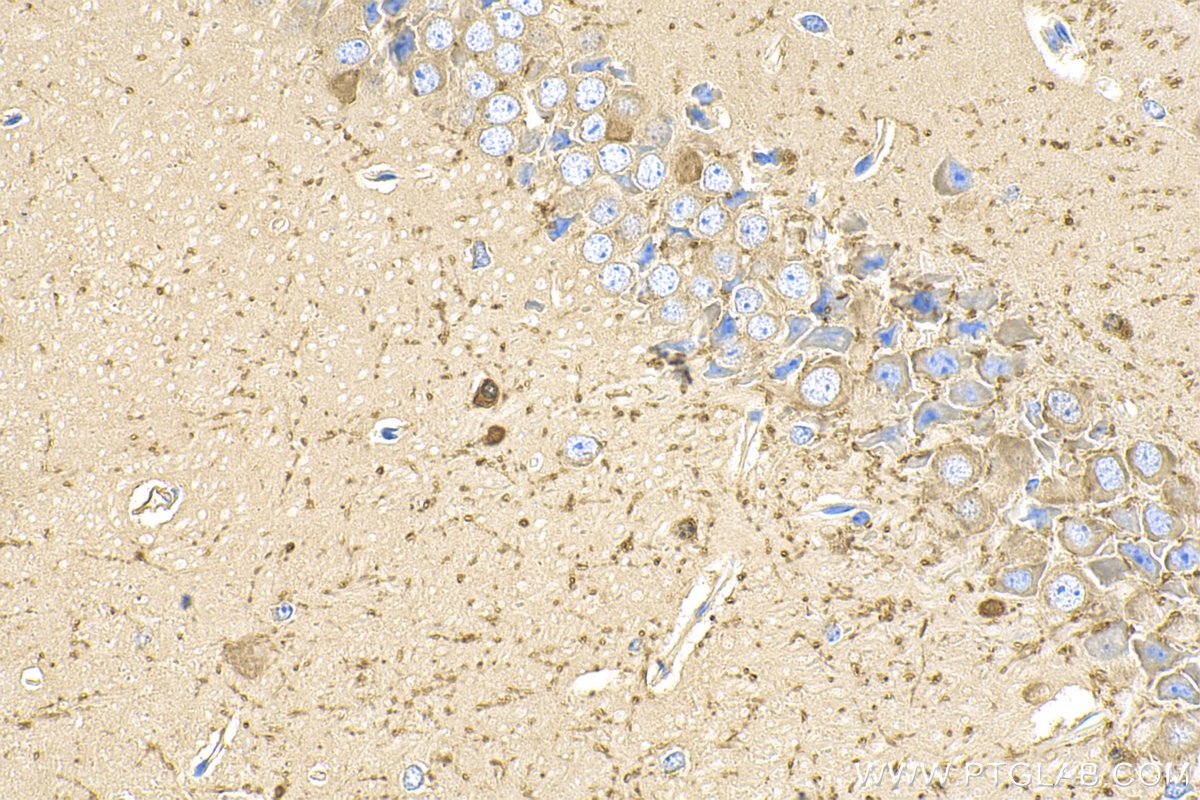Validation Data Gallery
Tested Applications
| Positive WB detected in | mouse liver tissue, human liver tissue |
| Positive IP detected in | mouse liver tissue |
| Positive IHC detected in | mouse brain tissue Note: suggested antigen retrieval with TE buffer pH 9.0; (*) Alternatively, antigen retrieval may be performed with citrate buffer pH 6.0 |
Recommended dilution
| Application | Dilution |
|---|---|
| Western Blot (WB) | WB : 1:500-1:2000 |
| Immunoprecipitation (IP) | IP : 0.5-4.0 ug for 1.0-3.0 mg of total protein lysate |
| Immunohistochemistry (IHC) | IHC : 1:50-1:500 |
| It is recommended that this reagent should be titrated in each testing system to obtain optimal results. | |
| Sample-dependent, Check data in validation data gallery. | |
Published Applications
| WB | See 5 publications below |
| IF | See 1 publications below |
Product Information
14908-1-AP targets QDPR in WB, IHC, IF, IP, ELISA applications and shows reactivity with human, mouse, rat samples.
| Tested Reactivity | human, mouse, rat |
| Cited Reactivity | human, mouse |
| Host / Isotype | Rabbit / IgG |
| Class | Polyclonal |
| Type | Antibody |
| Immunogen |
CatNo: Ag6705 Product name: Recombinant human QDPR protein Source: e coli.-derived, PGEX-4T Tag: GST Domain: 1-244 aa of BC000576 Sequence: MAAAAAAGEARRVLVYGGRGALGSRCVQAFRARNWWVASVDVVENEEASASIIVKMTDSFTEQADQVTAEVGKLLGEEKVDAILCVAGGWAGGNAKSKSLFKNCDLMWKQSIWTSTISSHLATKHLKEGGLLTLAGAKAALDGTPGMIGYGMAKGAVHQLCQSLAGKNSGMPPGAAAIAVLPVTLDTPMNRKSMPEADFSSWTPLEFLVETFHDWITGKNRPSSGSLIQVVTTEGRTELTPAYF 相同性解析による交差性が予測される生物種 |
| Full Name | quinoid dihydropteridine reductase |
| Calculated molecular weight | 26 kDa |
| Observed molecular weight | 28-30 kDa |
| GenBank accession number | BC000576 |
| Gene Symbol | QDPR |
| Gene ID (NCBI) | 5860 |
| RRID | AB_2173013 |
| Conjugate | Unconjugated |
| Form | |
| Form | Liquid |
| Purification Method | Antigen affinity purification |
| UNIPROT ID | P09417 |
| Storage Buffer | PBS with 0.02% sodium azide and 50% glycerol{{ptg:BufferTemp}}7.3 |
| Storage Conditions | Store at -20°C. Stable for one year after shipment. Aliquoting is unnecessary for -20oC storage. |
Background Information
Dihydropteridine reductase (QDPR), also named as DHPR and HDHPR, is an essential enzyme in the hydroxylating system of the aromatic amino acids, since it catalyses the regeneration of tetrahydrobiopterin (BH4), the natural cofactor of phenylalanine, tyrosine, and tryptophan hydroxylases, from the quininoid-dihydrobiopterin produced in these coupled reactions(PMID:8326489). The QDPR protein is active as a dimer, with a subunit Mr of 26 kDa(PMID:7627180). This protein belongs to the short-chain dehydrogenases/reductases (SDR) family. Defects in QDPR are the cause of BH4-deficient hyperphenylalaninemia type C (HPABH4C)(PMID:11153907).
Protocols
| Product Specific Protocols | |
|---|---|
| IHC protocol for QDPR antibody 14908-1-AP | Download protocol |
| IP protocol for QDPR antibody 14908-1-AP | Download protocol |
| WB protocol for QDPR antibody 14908-1-AP | Download protocol |
| Standard Protocols | |
|---|---|
| Click here to view our Standard Protocols |
Publications
| Species | Application | Title |
|---|---|---|
Glia Developmental maturation and regional heterogeneity but no sexual dimorphism of the murine CNS myelin proteome | ||
Mol Autism RNA sequencing and proteomics approaches reveal novel deficits in the cortex of Mecp2-deficient mice, a model for Rett syndrome. | ||
Front Mol Neurosci Broad Influence of Mutant Ataxin-3 on the Proteome of the Adult Brain, Young Neurons, and Axons Reveals Central Molecular Processes and Biomarkers in SCA3/MJD Using Knock-In Mouse Model. | ||
Genes Genomics Subproteomic profiling from renal cortices in OLETF rats reveals mutations of multiple novel genes in diabetic nephropathy. | ||
Sci Rep Identification and validation of diagnostic biomarkers for temporal lobe epilepsy related to ferroptosis and potential therapeutic targets |





